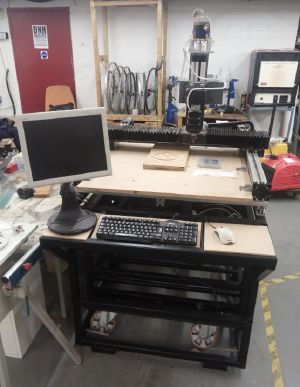Gantry CNC: Difference between revisions
Deanforbes (talk | contribs) |
m (Imperial not UCL!) |
||
| Line 21: | Line 21: | ||
This system can cut 2d and 3d shapes from materials such as wood, plastic, metal and composites. It is useful for cutting things that can't be cut in the laser cutter due to their thickness or material compatibility. The edge accuracy of parts is also usually better than a laser cut due to the lack of uncertainty about the kerf width, and improved vertical walls. | This system can cut 2d and 3d shapes from materials such as wood, plastic, metal and composites. It is useful for cutting things that can't be cut in the laser cutter due to their thickness or material compatibility. The edge accuracy of parts is also usually better than a laser cut due to the lack of uncertainty about the kerf width, and improved vertical walls. | ||
We made this CNC from the | We made this CNC from the Imperial donated linear slides and stages, and other things lying around the space, and some bits and pieces that members had. Any suggestions for improvements / modification are welcome. | ||
== Specs == | == Specs == | ||
Revision as of 19:33, 9 May 2016
Summary
This system can cut 2d and 3d shapes from materials such as wood, plastic, metal and composites. It is useful for cutting things that can't be cut in the laser cutter due to their thickness or material compatibility. The edge accuracy of parts is also usually better than a laser cut due to the lack of uncertainty about the kerf width, and improved vertical walls.
We made this CNC from the Imperial donated linear slides and stages, and other things lying around the space, and some bits and pieces that members had. Any suggestions for improvements / modification are welcome.
Specs
- Spindle
- Perske VS50.09 (see http://crpperske.com/pdf/Perske_Catalog_25AM.pdf)
- 1750 to 17500rpm
- 2.2kW driven by Siemens Micromaster 420 VFD
- ER20 extension collet chuck fitted
- Rapid traverse rate at 100% 2000mm/min (currently derated to 1200mm/min Jan 2016)
- Axis travel
- X(cross) 850mm
- Y(longitudinal) 960mm
- Z(vertical) 80mm (Phase 1), 62mm clear of current spoilboard, 200mm (Phase 2)
Technical
The system currently runs LinuxCNC on the PC built into the base.
Use / Induction
Once you have been trained and done a number of jobs on the shapeoko, you can by arrangement with the maintainers schedule an induction.
You will need to have demonstrated your ability on CAD and CAM.
You will need a LDAP account to login to the machine - further information on creating an account at https://wiki.london.hackspace.org.uk/view/LDAP#What_can_I_use_my_LDAP_account_for.3F
You must have completed 3 jobs on your own on either the ShapeOko or Boxford over a period of time
Operating the system
- The spindle is currently fitted with an ER20 collet chuck and can take cutters up to 13mm diameter. Collets can be found on top of the Boxford CNC. Please use only spanners to change and do so with care and respect
- To start the spindle, press the green button on the VFD. Use the up and down keys to vary the speed.
Charges
Charges are 10 Pounds an hour (spindle time) due to the nature of G code and home built machines you do so at your own risk (this is used for development costs and maintaince of the cnc machines) this goes into the blue tin until an account ios setup for this
Health and Saftey
- By using this machine you are self-certifying that you are competent to do so.
- You will not use this machine unless all safety features are in place and operational.
- You will not use this machine if you are under the influence of drugs ar alcohol. (this will result in a life time ban)
Generating g-code from your designs
There are a lot of different options for preparing a g-code file which can be loaded onto the CNC to cut a design. Some examples include;
3D Packages
- Autodesk Fusion 360 (Free for hobbyists and students, Windows / OSX) http://www.autodesk.co.uk/products/fusion-360/overview
2D Packages
- MakerCam (Free, runs in a browser via Flash) http://www.makercam.com/makercam.swf
- Cambam (LHS has a license, installed on the Robotics CAD/CAM laptop) http://www.cambam.info/
When using Fusion 360, in order to post to the Hackspace CNC machines, the "Generic EMC2" post-processor should be selected when finally saving the g-code file. LinuxCNC recognises the "ngc" file extension although any extension can be used.
System status
The system is up and running, although we are still doing some tidying and adjusting of subsystems based on initial experiences of people using it in the alpha/beta program. A low noise vacuum cleaner has been installed as a dust extraction system.
